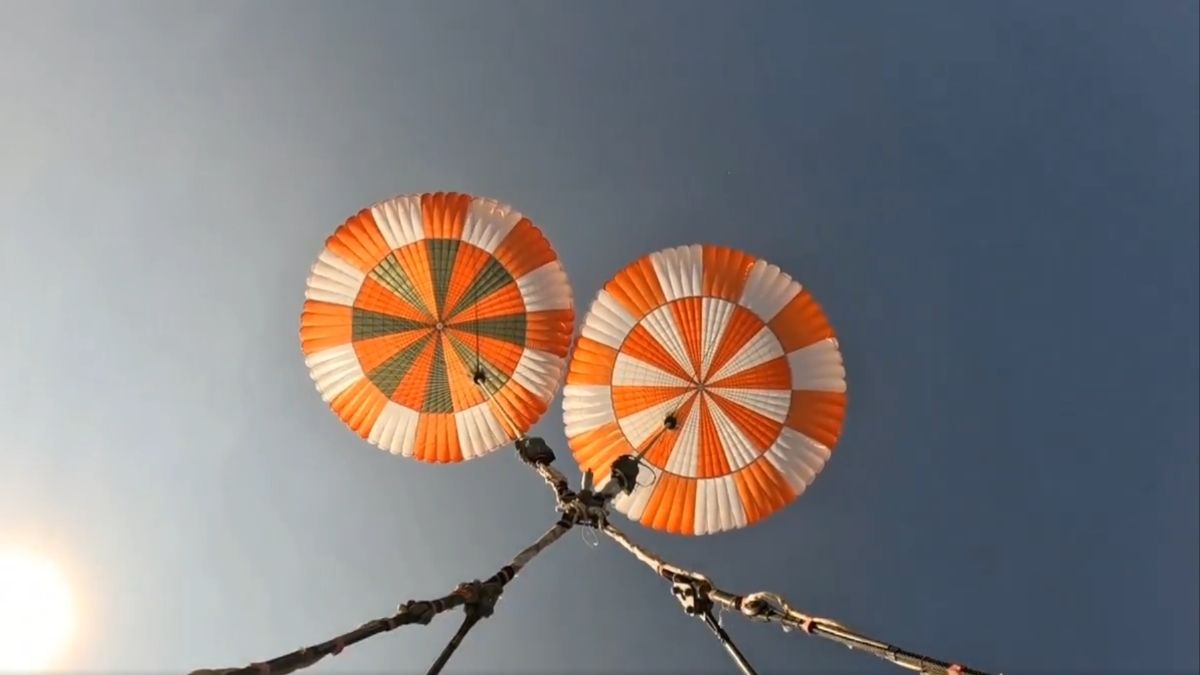Gaganyaan: What is an Integrated Main Parachute Airdrop Test?
 ISRO successfully conducted a key Integrated Main Parachute Airdrop Test (IMAT) | ISRO/X
ISRO successfully conducted a key Integrated Main Parachute Airdrop Test (IMAT) | ISRO/X
Have you ever wondered what happens if something goes wrong when astronauts return to Earth from space? Well, ISRO just showed us exactly how they are preparing for such scary moments. On November 3, 2025, at the Babina Field Firing Range in Jhansi, Uttar Pradesh, ISRO conducted a crucial test that wasn't about things going perfectly—it was about things going wrong and still keeping our astronauts safe.
This test was part of a series of Integrated Main Parachute Airdrop Tests (IMAT) to check and confirm that the parachute system for the Gaganyaan mission works safely and correctly. That's the real genius of the Gaganyaan mission's parachute system, and this is something every student aspiring to join India's space program should understand deeply.
Experts point out that the test is very special. Gaganyaan Crew Module uses not one, not two, but ten different parachutes working together like a perfectly coordinated team.
Think of it like your school's relay race team; everyone has a specific role, and they must work together flawlessly. These parachutes come in four different types: drogue parachutes that come out first like scouts, pilot parachutes that help deploy the main ones, and finally three large main parachutes that do the heavy work of slowing down the spacecraft for a gentle landing.
Redundancy measures
Now here's where ISRO's thinking becomes truly impressive. "ISRO has designed the system knowing that in space missions, Murphy's Law always applies: if something can go wrong, it might. So they built in what engineers call 'redundancy', which basically means having backup plans for your backup plans. Even if only two out of three main parachutes open properly, the astronauts will still land safely. Imagine playing cricket with just seven players instead of eleven, and still winning the match. That's the level of safety margin we're talking about," explained space expert Girish Linganna.
In this latest test, ISRO deliberately created a difficult situation. They delayed the full opening of the two main parachutes to see what would happen. "It's like your teacher giving you the toughest problem in the exam to check if you really understand the concept. The parachutes passed with flying colours. The system uses something called 'reefed inflation', where parachutes open slowly and gradually rather than all at once. Think of it like slowly releasing air from a balloon instead of popping it much more gently and safely," added Linganna.
The test also examined what happens when parachutes on one side open more slowly than the other. This asymmetric opening could cause the spacecraft to tilt or spin dangerously, but ISRO's design handled it beautifully. They dropped a dummy object weighing exactly the same as the actual Crew Module from 2.5 kilometres high using an Indian Air Force IL-76 aircraft, and it landed smoothly and safely.
When compared to international benchmarks, IMAT-03's success aligns with standards set by leading space programs. For instance, SpaceX's Dragon spacecraft—used by NASA for crewed missions to the International Space Station—employs a configuration of two drogue parachutes and four main parachutes to achieve redundancy and stability during descent. Dragon's system can ensure a safe landing even in the event of a parachute malfunction, similar in principle to Gaganyaan's triple-main configuration. However, Dragon integrates parachutes with a propulsive landing system powered by SuperDraco thrusters, providing additional precision control. Gaganyaan, by contrast, relies entirely on its advanced parachute mechanism, a design philosophy that reflects India's focus on simplicity, reliability, and cost-effective engineering.
"At the heart of Gaganyaan's design lies the principle of redundancy, the foundation of human spaceflight safety. The triple-main parachute configuration ensures that even with one parachute failing or deploying late, the remaining two can guarantee a safe landing. Redundant pyrotechnic systems, pressure sensors, and independent triggering circuits further minimise the risk of single-point failures. This multi-layered safety architecture ensures balanced deceleration and stability during descent, aligning with stringent international human-rating standards.
The IMAT-03 success demonstrates that India's human spaceflight systems adhere to the same level of safety and performance seen in NASA, ESA, and other major space programs," pointed out Srimathy Kesan, the CEO and Founder of SpaceKidz India.
She further points out that India's expertise in recovery technology has evolved over decades, beginning with the Space Capsule Recovery Experiment (SRE-1) in 2007, which successfully demonstrated splashdown and retrieval capabilities.
This heritage has been refined through numerous ground and airdrop tests, culminating in large-scale validations like IMAT-03. "Each step has advanced India's capability to design sophisticated mechanisms such as reefed parachute deployment, timed disreefing, and complex load management systems technologies vital for ensuring astronaut safety during re-entry and recovery," remarked Kesan.
The success of IMAT-03 holds immense strategic significance for India's human spaceflight ambitions. It confirms the readiness of one of the final major systems required for the crew module's human-rating qualification and establishes India's technological independence in designing, testing, and validating advanced recovery systems. IMAT-03 is the third in a series of at least five planned integrated parachute tests, each designed to simulate different environmental conditions and potential failure modes. These evaluations form a critical part of ISRO's rigorous roadmap toward Gaganyaan's first uncrewed mission, expected before March 2026.
Sci/Tech